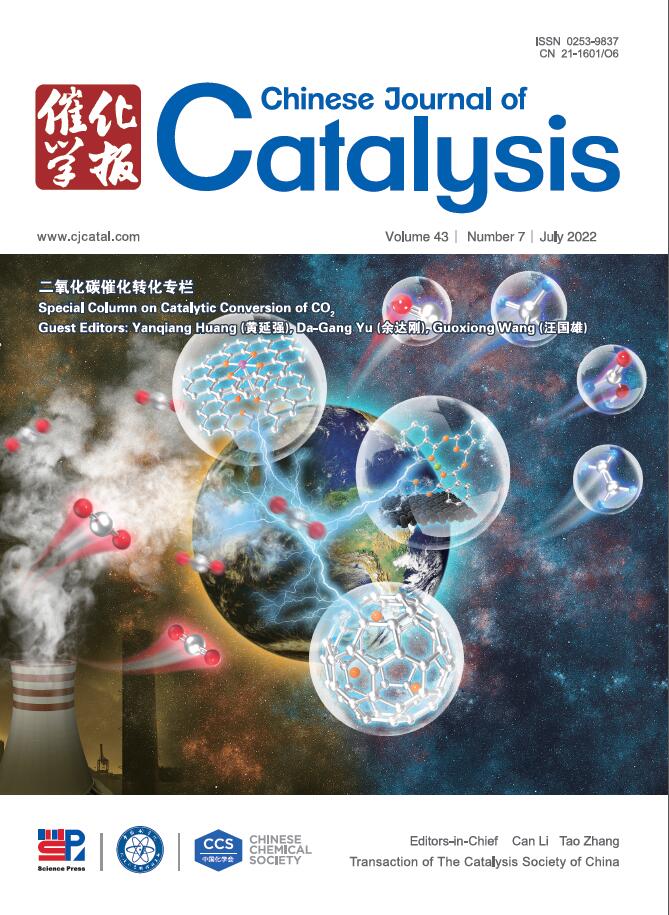高熵合金纳米晶体促进光催化析氢和肉桂醇选择性氧化
IF 15.7
1区 化学
Q1 CHEMISTRY, APPLIED
引用次数: 0
摘要
摘要光催化利用太阳光进行耦合制氢和可控有机转化,为解决世界范围内能源和工业重要原料短缺问题提供了一条有前景的解决方案。在此,我们证明了PtFeNiCoCu高熵合金(HEA)纳米晶体可以作为有效的助催化剂,通过均匀尺寸为4.0±0.5 nm的立方硫化镉(CdS)量子点(QDs),催化氢的析出以及肉桂醇选择性氧化成肉桂醛。采用简单的溶剂热法制备了HEA纳米晶体,并通过静电自组装方法成功地与CdS量子点集成,构建了HEA/CdS复合材料。优化后的HEA/CdS样品光催化制氢速率为7.15 mmol g-1 h-1,是纯CdS QDs的13倍。光反应3 h后,肉桂醇的转化率为96.2%,肉桂醛的选择性为99.5%。HEA与CdS量子点的集成将光吸收边从475 nm扩展到484 nm。从d波段中心分析,HEA中的Pt原子是H2演化的活性位点,表现出比纯Pt更高的催化活性。同时,CdS量子点的能带结构使得肉桂醇氧化转化为肉桂醛具有高选择性。此外,飞秒瞬态吸收光谱表明,HEA可以显著促进CdS中光生载流子的分离,这对于实现增强的光催化活性至关重要。这项工作启发了光催化材料的原子水平设计,以协调生产绿色能源载体和增值产品。本文章由计算机程序翻译,如有差异,请以英文原文为准。
High-entropy alloy nanocrystals boosting photocatalytic hydrogen evolution coupled with selective oxidation of cinnamyl alcohol
ABSTRACT
Photocatalysis provides a promising solution to the worldwide shortages of energy and industrially important raw materials by utilizing sunlight for coupled hydrogen (H2) production with controllable organic transformation. Herein, we demonstrate that PtFeNiCoCu high-entropy alloy (HEA) nanocrystals can act as efficient cocatalysts for H2 evolution coupled with selective oxidation of cinnamyl alcohol to cinnamaldehyde by cubic cadmium sulfide (CdS) quantum dots (QDs) with uniform sizes of 4.0 ± 0.5 nm. HEA nanocrystals were prepared via a simple solvothermal approach, and were successfully integrated with CdS QDs by an electrostatic self-assembly method to construct HEA/CdS composites. The optimized HEA/CdS sample presented an enhanced photocatalytic H2 production rate of 7.15 mmol g–1 h–1, which was 13 times that of pure CdS QDs. Moreover, a cinnamyl alcohol conversion of 96.2% with cinnamaldehyde selectivity of 99.5% was achieved after photoreaction for 3 h. The integration of HEA with CdS QDs extended the optical absorption edge from 475 to 484 nm. From d-band center analysis, Pt atoms in the HEA are the active sites for H2 evolution, exhibiting higher catalytic activity than pure Pt. Meanwhile, the band structure of the CdS QDs enables the oxidative transformation of cinnamyl alcohol to cinnamaldehyde with high selectivity. Moreover, femtosecond transient absorption spectroscopy shows that HEA can significantly promote the separation of photogenerated carriers in CdS, which is vital for achieving enhanced photocatalytic activity. This work inspires atomic-level design of photocatalytic materials for coordinated production of green energy carriers and value-added products.
求助全文
通过发布文献求助,成功后即可免费获取论文全文。
去求助
来源期刊

Chinese Journal of Catalysis
工程技术-工程:化工
CiteScore
25.80
自引率
10.30%
发文量
235
审稿时长
1.2 months
期刊介绍:
The journal covers a broad scope, encompassing new trends in catalysis for applications in energy production, environmental protection, and the preparation of materials, petroleum chemicals, and fine chemicals. It explores the scientific foundation for preparing and activating catalysts of commercial interest, emphasizing representative models.The focus includes spectroscopic methods for structural characterization, especially in situ techniques, as well as new theoretical methods with practical impact in catalysis and catalytic reactions.The journal delves into the relationship between homogeneous and heterogeneous catalysis and includes theoretical studies on the structure and reactivity of catalysts.Additionally, contributions on photocatalysis, biocatalysis, surface science, and catalysis-related chemical kinetics are welcomed.
 求助内容:
求助内容: 应助结果提醒方式:
应助结果提醒方式:


